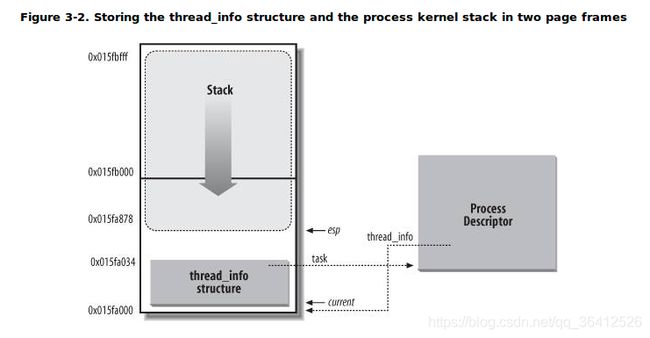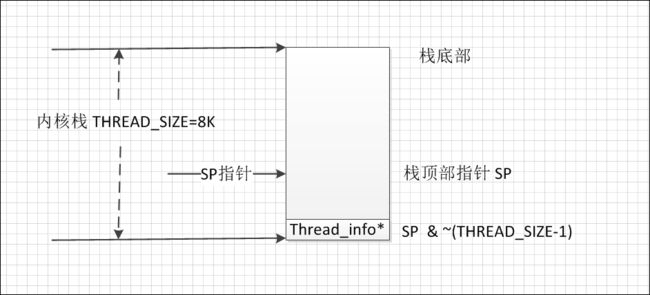linux内核中task_struct与thread_info及stack三者的关系
在linux内核中进程以及线程(多线程也是通过一组轻量级进程实现的)都是通过task_struct结构体来描述的,我们称它为进程描述符。而thread_info则是一个与进程描述符相关的小数据结构,它同进程的内核态栈stack存放在一个单独为进程分配的内存区域。由于这个内存区域同时保存了thread_info和stack,所以使用了联合体来定义,相关数据结构如下(基于4.4.87版本内核):
thread_union联合体定义:
union thread_union {
struct thread_info thread_info;
unsigned long stack[THREAD_SIZE/sizeof(long)];
};
thread_info结构体定义:
struct thread_info {
unsigned long flags; /* low level flags */
mm_segment_t addr_limit; /* address limit */
struct task_struct *task; /* main task structure */
int preempt_count; /* 0 => preemptable, <0 => bug */
int cpu; /* cpu */
};
- 的结构比较复杂,只列出部分成员变量:
struct task_struct {
volatile long state;
void *stack;
//...
#ifdef CONFIG_SMP
int on_cpu;
int wake_cpu;
#endif
int on_rq;
//...
#ifdef CONFIG_SCHED_INFO
struct sched_info sched_info;
#endif
//...
pid_t pid;
pid_t tgid;
//...
};
这样设计的好处就是,得到stack,thread_info或task_struct任意一个数据结构的地址,就可以很快得到另外两个数据的地址。
我们可以通过crash工具在ubuntu系统上做个实验,来窥视一下某个进程的进程描述符
如果通过crash分析内核数据结构,可参考:
http://www.cnblogs.com/yanghaizhou/p/7704421.html
这里以进程systemd进程为例,其pid=1
crash> task 1
PID: 1 TASK: ffff88007c898000 CPU: 1 COMMAND: "systemd"
struct task_struct {
state = 1,
stack = 0xffff88007c894000,
usage = {
counter = 2
},
。。。
可以看到systemd进程的task_struct结构体指针task=0xffff88007c898000
通过task->stack这个结构体成员即可定位到进程的内核栈地址 stack=0xffff88007c894000
另外从之前的图可以看到,thread_info和stack处于同一地址空间,且thread_info在这段地址空间的最低地址处,而且这个地址空间是以THREAD_SIZE对齐的,所以只要将stack地址的最低N位变为0,即可得到thread_info的地址(2^N=THREAD_SIZE)
例如当THREAD_SZIE=8K时,systemd的thread_info地址就等于0xffff88007c894000&(~(0x1FFF)) = 0xffff88007c894000
crash> * thread_info 0xffff88007c894000
struct thread_info {
task = 0xffff88007c898000,
flags = 0,
status = 0,
cpu = 0,
addr_limit = {
seg = 140737488351232
},
sig_on_uaccess_error = 0,
uaccess_err = 0
}
而通过thread_info->task这个成员变量,又能访问到进程的task_struct结构体,这样就形成了task_struct, thread_info,stack三者之间的关系网,知道其中任何一个,都可以快速的访问到另外两个,提高了数据存取的效率。
-------------------------------------------------------------------------------------------------------------------------------------------------------------------------
内核 current宏解析
在内核中,可以通过current宏来获得当前执行进程的task_struct指针。现在来简要分析以下:
最原始的定义如下:
#define current get_current() #define get_current() (current_thread_info()->task)
可以看出,current调用了 current_thread_info函数,此函数的内核路径为: arch/arm/include/asm/thread_info.h,内核版本为2.6.32.65 static inline struct thread_info *current_thread_info(void)
{
register unsigned long sp asm ("sp");
return (struct thread_info *)(sp & ~(THREAD_SIZE - 1));
}
其中 thread_info结构体如下:
struct thread_info {
unsigned long flags; /* low level flags */
int preempt_count; /* 0 => preemptable, <0 => bug */
mm_segment_t addr_limit; /* address limit */
struct task_struct *task; /* main task structure */
struct exec_domain *exec_domain; /* execution domain */
__u32 cpu; /* cpu */
__u32 cpu_domain; /* cpu domain */
struct cpu_context_save cpu_context; /* cpu context */
__u32 syscall; /* syscall number */
__u8 used_cp[16]; /* thread used copro */
unsigned long tp_value;
struct crunch_state crunchstate;
union fp_state fpstate __attribute__((aligned(8)));
union vfp_state vfpstate;
#ifdef CONFIG_ARM_THUMBEE
unsigned long thumbee_state; /* ThumbEE Handler Base register */
#endif
struct restart_block restart_block;
};当内核线程执行到此处时,其SP堆栈指针指向调用进程所对应的内核线程的栈顶。通过 sp & ~(THREAD_SIZE-1)向上对齐,达到栈底部。如下图所示
将结果强制类型转换为thread_info类型,此类型中有一个成员为task_struct,它就是 当前正在运行进程的 task_struct指针。
备注:
在内核中,进程的task_struct是由slab分配器来分配的,slab分配器的优点是对象复用和缓存着色。
联合体:
#define THREAD_SIZE 8192 //内核线程栈 可以通过内核配置成4K 或者 8K ,此处是8K 。在X86体系结构上,32位的内核栈为8K,64位的为16K。
union thread_union {
struct thread_info thread_info; // sizeof(thread_info) =
unsigned long stack[THREAD_SIZE/sizeof(long)]; //stack 大小为 8K,union联合体的地址是严格按照小端排布的,因此,内核栈的低位地址是thread_info结构体。
};
整个8K的空间,顶部供进程堆栈使用,最下部为thread_info。从用户态切换到内核态时,进程的内核栈还是空的,所以sp寄存器指向栈顶,一旦有数据写入,sp的值就会递减,内核栈按需扩展,理论上最大可扩展到 【8192- sizeof(thread_info) 】大小,考虑到函数的现场保护,往往不会有这么大的栈空间。内核在代表进程执行时和所有的中断服务程序执行时,共享8K的内核栈。
---------------------------------------------------------------------------------------------------------------------------------------------------------------------
Linux源码解析-内核栈与thread_info结构详解
1.什么是进程的内核栈?
在内核态(比如应用进程执行系统调用)时,进程运行需要自己的堆栈信息(不是原用户空间中的栈),而是使用内核空间中的栈,这个栈就是进程的内核栈
2.进程的内核栈在计算机中是如何描述的?
linux中进程使用task_struct数据结构描述,其中有一个stack指针
-
struct task_struct -
{ -
// ... -
void *stack; // 指向内核栈的指针 -
// ... -
};
task_struct数据结构中的stack成员指向thread_union结构(Linux内核通过thread_union联合体来表示进程的内核栈)
-
union thread_union { -
struct thread_info thread_info; -
unsigned long stack[THREAD_SIZE/sizeof(long)]; -
};
struct thread_info是记录部分进程信息的结构体,其中包括了进程上下文信息:
-
struct thread_info { -
struct pcb_struct pcb; /* palcode state */ -
struct task_struct *task; /* main task structure */ /*这里很重要,task指针指向的是所创建的进程的struct task_struct -
unsigned int flags; /* low level flags */ -
unsigned int ieee_state; /* see fpu.h */ -
struct exec_domain *exec_domain; /* execution domain */ /*表了当前进程是属于哪一种规范的可执行程序, -
//不同的系统产生的可执行文件的差异存放在变量exec_domain中 -
mm_segment_t addr_limit; /* thread address space */ -
unsigned cpu; /* current CPU */ -
int preempt_count; /* 0 => preemptable, <0 => BUG */ -
int bpt_nsaved; -
unsigned long bpt_addr[2]; /* breakpoint handling */ -
unsigned int bpt_insn[2]; -
struct restart_block restart_block; -
};
![]()
从用户态刚切换到内核态以后,进程的内核栈总是空的。因此,esp寄存器指向这个栈的顶端,一旦数据写入堆栈,esp的值就递减
3.thread_info的作用是?
这个结构体保存了进程描述符中中频繁访问和需要快速访问的字段,内核依赖于该数据结构来获得当前进程的描述符(为了获取当前CPU上运行进程的task_struct结构,内核提供了current宏。
-
#define get_current() (current_thread_info()->task) -
#define current get_current()
内核还需要存储每个进程的PCB信息, linux内核是支持不同体系的的, 但是不同的体系结构可能进程需要存储的信息不尽相同,
这就需要我们实现一种通用的方式, 我们将体系结构相关的部分和无关的部门进行分离,用一种通用的方式来描述进程, 这就是struct task_struct, 而thread_info
就保存了特定体系结构的汇编代码段需要访问的那部分进程的数据,我们在thread_info中嵌入指向task_struct的指针, 则我们可以很方便的通过thread_info来查找task_struct
3.内核栈的大小?
进程通过alloc_thread_info函数分配它的内核栈,通过free_thread_info函数释放所分配的内核栈,查看源码
alloc_thread_info函数通过调用__get_free_pages函数分配2个页的内存(8192字节)
https://blog.csdn.net/gatieme/article/details/51577479

